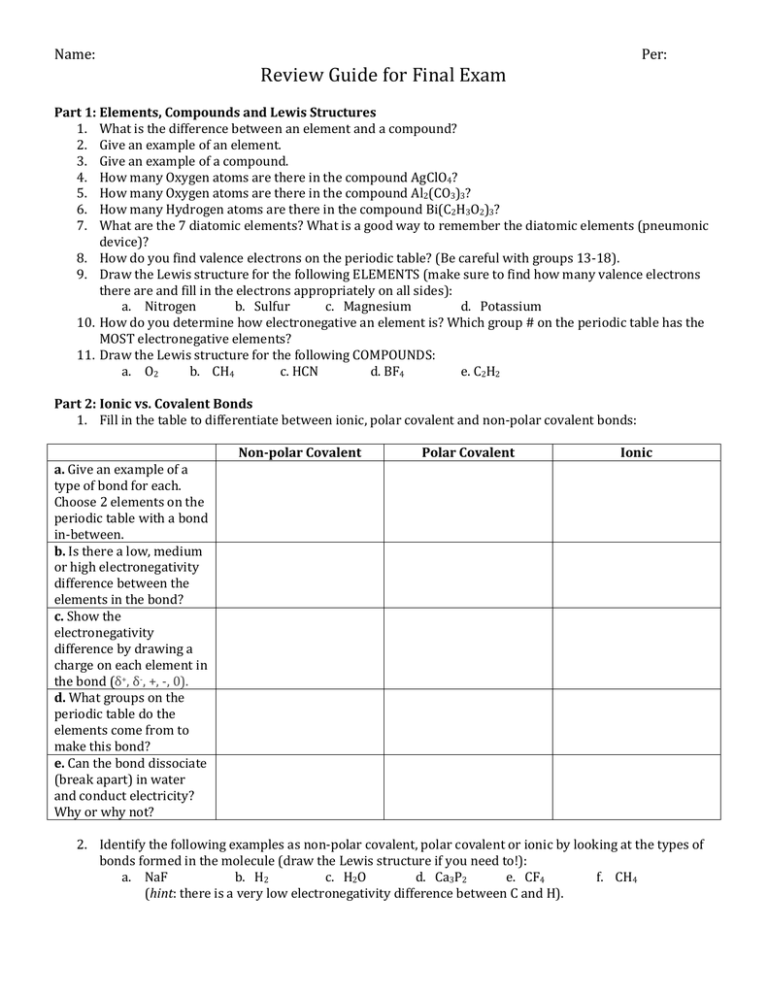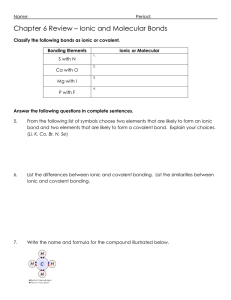Name: Per: Review Guide for Final Exam Part 1: Elements
advertisement

Name: Per: Review Guide for Final Exam Part 1: Elements, Compounds and Lewis Structures 1. What is the difference between an element and a compound? 2. Give an example of an element. 3. Give an example of a compound. 4. How many Oxygen atoms are there in the compound AgClO4? 5. How many Oxygen atoms are there in the compound Al2(CO3)3? 6. How many Hydrogen atoms are there in the compound Bi(C2H3O2)3? 7. What are the 7 diatomic elements? What is a good way to remember the diatomic elements (pneumonic device)? 8. How do you find valence electrons on the periodic table? (Be careful with groups 13-18). 9. Draw the Lewis structure for the following ELEMENTS (make sure to find how many valence electrons there are and fill in the electrons appropriately on all sides): a. Nitrogen b. Sulfur c. Magnesium d. Potassium 10. How do you determine how electronegative an element is? Which group # on the periodic table has the MOST electronegative elements? 11. Draw the Lewis structure for the following COMPOUNDS: a. O2 b. CH4 c. HCN d. BF4 e. C2H2 Part 2: Ionic vs. Covalent Bonds 1. Fill in the table to differentiate between ionic, polar covalent and non-polar covalent bonds: Non-polar Covalent Polar Covalent Ionic a. Give an example of a type of bond for each. Choose 2 elements on the periodic table with a bond in-between. b. Is there a low, medium or high electronegativity difference between the elements in the bond? c. Show the electronegativity difference by drawing a charge on each element in the bond (δ+, δ-, +, -, 0). d. What groups on the periodic table do the elements come from to make this bond? e. Can the bond dissociate (break apart) in water and conduct electricity? Why or why not? 2. Identify the following examples as non-polar covalent, polar covalent or ionic by looking at the types of bonds formed in the molecule (draw the Lewis structure if you need to!): a. NaF b. H2 c. H2O d. Ca3P2 e. CF4 f. CH4 (hint: there is a very low electronegativity difference between C and H). Name: Per: 3. CIRCLE a polar covalent bond in the molecule to the right and BOX a non-polar covalent bond in the molecule. Indicate partial positive and negative charges on the polar bond. Part 3: Writing and Naming Ionic Bonds 1. How are ionic bonds formed? Use the vocabulary terms cation, anion, metal, non-metal, + charge, - charge and transfer of electrons in your explanation. 2. Write the chemical formula for the ionic bond between the following elements using the correct charges and subscripts: a. Potassium (K) and Phosphorus (P) b. Fe (III) and Oxygen (O) c. Calcium (Ca) and Sulfur (S) d. Barium (Ba) and Nitrogen (N) 3. Write the correct NAME for each of the ionic bonds you wrote in #2. Does the cation or anion name change and how? Part 4: Intermolecular Forces 1. Draw partial charges and a vector arrow indicating a dipole moment on the molecule to the right: 2. Name the type of intermolecular interaction occurring below and explain why you labeled it that way: a. b. (hint: the electronegativity difference between C and H is very low) c. 3. Look at the molecules below and determine what type of intermolecular forces they will engage in if there were 2 of each (interacting with themselves): a. b. c. Name: Per: Part 5: Reaction Identification and Writing 1. What are 4 signs of a chemical reaction? 2. Identify the following reactions as either Synthesis (S), Decomposition (D), Combustion (C), Single Replacement (SR), or Double Replacement (DR): a. _________ 2KClO3(s) → 2KCl(s) + 3O2(g) b. _________ Cl2(g) + 2NaBr(aq) → 2NaCl(aq) + Br2(l) c. _________ 2CH3OH(g) + 3O2(g) 2CO2 (g) + 4H2O(g) d. _________ N2(g) + 3H2(g) → 2NH3(g) e. _________ C10H8(g) + 12O2(g) → 10CO2(g) + 4H2O(g) f. _________ 2HNO3(aq) + Mg(OH)2(aq) → Mg(NO3)2(aq) + 2H2O(l) g. _________ Mg(s) + CuSO4(aq) → MgSO4(aq) + Cu(s) 3. Synthesis reactions: a. Potassium reacts with oxygen to create potassium oxide. **Keep track of charges!!! b. Ca + S __________ c. Fe (II) + O2 ___________ 4. Decomposition reactions: a. Water decomposes into hydrogen and oxygen gas. b. LiF ________ + ________ c. AgCl2 _________ + _________ 5. Single Replacement reactions: a. ZnBr2(aq) + F2(g) _______ + _______ (treat H as a +1 ion) b. Iron (I) reacts with HCl to create hydrogen gas and iron (I) chloride. c. Cl2(g) + KBr(aq) _______ + _______ 6. Double Replacement reactions: a. AlI3 + HgCl2 __________ + __________ b. CuBr2 + AlCl3 _________ + __________ c. Be3N2 + CaCl2 _________ + ________ Part 6: Conservation of Mass 1. State the law of conservation of mass. 2. What is one procedure we use to show that mass is conserved in a chemical reaction? 3. Coefficient practice – use the chemical equation below to answer A-C. 2Al(NO3)3(aq) + 3Ca(s) → 3Ca(NO3)2(aq) + 2Al(s) a. How many oxygen atoms are there in the compound 2Al(NO3)3? b. How many nitrogen atoms are there in the compound 3Ca(NO3)3? c. How many calcium atoms are there in the compound 3Ca(NO3)3? 4. Balance the following simple equations using coefficients: a. ___Na + ___Cl2 ___NaCl b. ___H2O ___H2 + ___O2 c. ___Be3N2 ___Be + ___N2 5. Balance the following medium level equations using coefficients: a. ____SO2 + ____H2 ____H2S + ____H2O b. ____CH4 + ____S ____CS2 + ____H2S c. ____C2H4 + ____O2 ____CO2 + ____H2O Name: Per: Synthesis Question: Use the reaction below to answer the questions that follow: _____CH4 + _____O2 _____H2O + _____CO2 1. 2. 3. 4. Name the TYPE of reaction occurring above. Balance the reaction using your knowledge of the conservation of mass. Draw the reaction over again using Lewis structures for each compound. Identify the type of intermolecular force each compound engages in with ITSELF (4 compounds, 4 force identifications).






